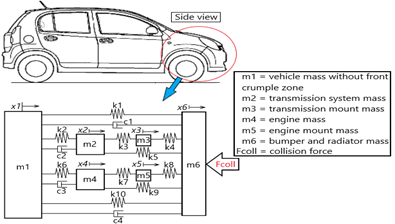Main Article Content
Abstract
The effectiveness of a vehicle crash system depends on how well it can simulate the behavior of a real vehicle in a crash scenario and accurately identifies the correct working limits of the model parameters, including mass, spring, and damper. Therefore, this study explores the modelling vehicle front crumple zone to represent the behaviors of real crash scenario. The modelling process using Kamal approach is used to develop a precise vehicle crash model for analyzing the impact of a collision on both the vehicle and its passengers. In this study, a complex mass-spring-damper system representing the front crumple zone of an actual car is re-designed to modify the existing vehicle crash model. The gravitational search algorithm (GSA) is implemented in the simulation model's code to obtain optimized values of damping coefficient (c) and spring constant (k). The simulation results show that the deformation response of crumple zone and the deceleration response of vehicle body match the experimental results, indicating the model's accuracy. Additionally, this study investigates the effects of varying the GSA parameters' number of agents (N), the beta parameter (β), and the gravitational constant (G) to improve the model's accuracy by minimizing the root mean square error (RMSE) between model response and crash test data. The optimal GSA parameter chosen in this study were N = 50, β = 0.3, and G = 20 with the lowest RMSE of 22.3874, 22.26664, and 23.86638 respectively.
Keywords
Article Details

This work is licensed under a Creative Commons Attribution-NonCommercial 4.0 International License.
References
- K. V. P. Luján et al., “Accidental injuries caused by automotive frontal collision,” Latin American Journal of Solids and Structures, vol. 18, 2021, doi: 10.3390/s22249720.
- D. Frej and M. Jaśkiewicz, “Comparison of Volunteers’ Head Displacement with Computer Simulation—Crash Test with Low Speed of 20 km/h,” Sensors, vol. 22, no. 24, p. 9720, 2022.
- G. Noorsumar, S. Rogovchenko, K. G. Robbersmyr, and D. Vysochinskiy, “Mathematical models for assessment of vehicle crashworthiness: a review,” International journal of crashworthiness, vol. 27, no. 5, pp. 1545–1559, 2022, doi: 10.1080/13588265.2021.1929760.
- A. R. Fekry, W. A.-H. Oraby, and M. A. Ali, “Vehicle body pitch control through integration of MR damping system implemented in both vehicle suspension and front-end structure,” Proceedings of the Institution of Mechanical Engineers, Part D: Journal of Automobile Engineering, vol. 237, no. 5, pp. 1082–1092, 2023, doi: 10.1177/09544070221083736.
- S. Wang, L. Hua, C. Yang, Y. Zhang, and X. Tan, “Nonlinear vibrations of a piecewise-linear quarter-car truck model by incremental harmonic balance method,” Nonlinear Dynamics, vol. 92, pp. 1719–1732, 2018, doi: 10.1007/s11071-018-4157-6.
- S. M. Ofochebe, S. O. Enibe, and C. G. Ozoegwu, “Absorbable energy monitoring scheme: new design protocol to test vehicle structural crashworthiness,” Heliyon, vol. 2, no. 5, pp. 1–33, 2016, doi: 10.1016/j.heliyon.2016.e00107.
- S. Karapetkov and L. Dimitrov, “An Update on the Momentum 360 Method of Vehicle Impact Reconstruction through 3D Modeling and Computer Simulation,” Symmetry, vol. 14, no. 12, p. 2628, 2022, doi: 10.3390/sym14122628.
- B. B. Munyazikwiye, D. Vysochinskiy, M. Khadyko, and K. G. Robbersmyr, “Prediction of vehicle crashworthiness parameters using piecewise lumped parameters and finite element models,” Designs, vol. 2, no. 4, p. 43, 2018, doi: 10.3390/designs2040043.
- M. Elkady, A. Elmarakbi, J. MacIntyre, and M. Alhariri, “Collision mitigation and vehicle transportation safety using integrated vehicle dynamics control systems,” Journal of traffic and transportation engineering (english edition), vol. 4, no. 1, pp. 41–60, 2017, doi: 10.1016/j.jtte.2016.08.002.
- TRL, “TRL | The Future of Transport,” trl.ac.uk, 2021. .
- P. K. Archakam and S. Muthuswamy, “Design and simulation of a crash energy absorption system integrated with magneto-rheological absorber,” Journal of Vibration Engineering & Technologies, vol. 9, no. 7, pp. 1635–1656, 2021, doi: 10.1007/s42417-021-00318-6.
- M. S. Rahmat, K. Hudha, Z. Abd Kadir, N. H. Amer, M. L. H. Abd Rahman, and S. Abdullah, “Modelling and validation of magneto-rheological fluid damper behaviour under impact loading using interpolated multiple adaptive neuro-fuzzy inference system,” Multidiscipline Modeling in Materials and Structures, vol. 16, no. 6, pp. 1395–1415, 2020, doi: 10.1108/MMMS-10-2019-0187.
- J. M. Lim, “Lumped mass-spring model construction for crash analysis using full frontal impact test data,” International journal of automotive technology, vol. 18, pp. 463–472, 2017, doi: 10.1007/s12239-017-0046-0.
- W. Pawlus, H. R. Karimi, and K. G. Robbersmyr, “Investigation of vehicle crash modeling techniques: theory and application,” The International Journal of Advanced Manufacturing Technology, vol. 70, pp. 965–993, 2014, doi: 10.1007/s00170-013-5320-3.
- A. I. Radu, G. R. Toganel, and D. D. Trusca, “Mathematical model validated by a crash test to be used as kinematic and dynamic study for side impacts,” International journal of automotive technology, vol. 22, pp. 1267–1277, 2021, doi: 10.1007/s12239-021-0111-6.
- S. C. Deac, A. Perescu, D. Simoiu, E. Nyaguly, I. Crâştiu, and L. Bereteu, “Modeling and simulation of cars in frontal collision,” in IOP Conference Series: Materials Science and Engineering, 2018, vol. 294, no. 1, p. 12090, doi: 10.1088/1757-899X/294/1/012090.
- W. Pawlus, K. G. Robbersmyr, and H. R. Karimi, “Mathematical modeling and parameters estimation of a car crash using data-based regressive model approach,” Applied Mathematical Modelling, vol. 35, no. 10, pp. 5091–5107, 2011, doi: 10.1016/j.apm.2011.04.024.
- J.-S. Wang and J.-D. Song, “Function optimization and parameter performance analysis based on gravitation search algorithm,” Algorithms, vol. 9, no. 1, p. 3, 2015, doi: 10.3390/a9010003.
- E. Rashedi, E. Rashedi, and H. Nezamabadi-Pour, “A comprehensive survey on gravitational search algorithm,” Swarm and evolutionary computation, vol. 41, pp. 141–158, 2018, doi: 10.1016/j.swevo.2018.02.018.
- N. Siddique and H. Adeli, “Gravitational search algorithm and its variants,” International Journal of Pattern Recognition and Artificial Intelligence, vol. 30, no. 08, p. 1639001, 2016, doi: 10.1007/s11042-020-09831-4.
- Y. Wang, S. Gao, M. Zhou, and Y. Yu, “A multi-layered gravitational search algorithm for function optimization and real-world problems,” IEEE/CAA Journal of Automatica Sinica, vol. 8, no. 1, pp. 94–109, 2020, doi: 10.1109/JAS.2020.1003462.

